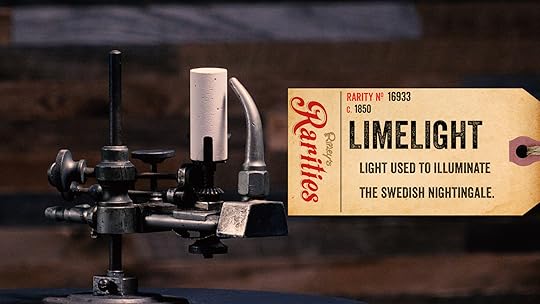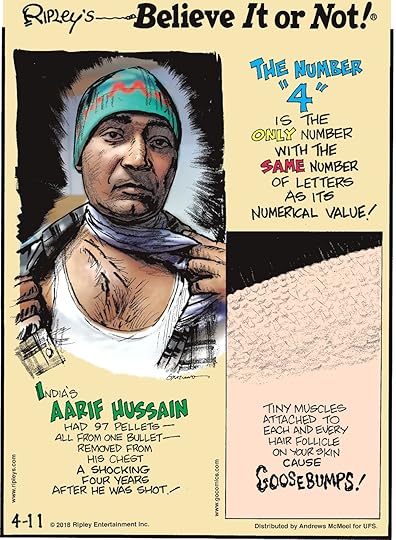Ripley Entertainment Inc.'s Blog, page 350
April 13, 2018
CARTOON 04-13-2018
April 12, 2018
Prada Marfa And The Mysteries Of Middle Of Nowhere, Texas
Featured in Ripley's Believe It or Not!

Marfa, Texas, is an enigmatic and offbeat place where art meets desert and out-of-place fashion makes a wry statement.
A tiny town in West Texas, Marfa is known as an obscure hub for the arts and creativity, fittingly named after a character from a Dostoyevsky novel. Seemingly plonked in the middle of limitless desolation, Marfa boasts a population of less than 2,000. Though has only one blinking stop light, it contains an uncanny number of art studios, galleries, and intriguing installations.
With its wide-open stretches of barren landscape, it is also a polestar for Hollywood. The 1956 film Giant was filmed here, as well as No Country For Old Men and There Will Be Blood, all of which have won Academy Awards.
Why is Marfa so attractive to Hollywood? Locals might say it’s the town’s eclectic energy, artists may tell you it’s the great light. In fact, at night one might witness the mythical Marfa Lights, which–depending on who you speak to–could be atmospheric reflections, paranormal phenomena, or simply whimsical mysteries.
Large-Scale Visual Drama
Although a mecca for creative types, you won’t find an “art district” per se, but rather smatterings of galleries and studios, and imposing larger-than-life installations. Donald Judd was the established artist whose works—labelled minimalistic in their embellishment—turned Marfa into a haven for international art aficionados.
In the 1970s, Judd acquired an Army base and began filling it with art, inextricably linking the landscape with the art. Flanking the Chinati Foundation that he founded, Judd installed 15 large concrete blocks that transform the perception of space, even a space as vast as Marfa. You must walk through “daunting” fields to get to some of these works but, upon arrival, it’s a surreal place to sit and ponder the everythings and nothings of life.

Store as Sculpture
Another great oddity, situated on the dusty outskirts of Marfa, lies as a landmark so strange that you’d wonder aloud “What’s that up ahead?” as you drive down US 90. That up ahead would be Prada Marfa. Prada, you say? Yes, the Italian designer label that would make any chic fashionista’s head spin at mere mention. What on earth is a Prada store doing smack dab in the heart of Nowhere, Texas?
These are some of the questions the Nordic design team of Michael Elmgreen and Ingar Dragset want you to ask. In 2005, the duo set out to create a small structure resembling a Prada store, complete with the year’s fall/winter collection of shoes and handbags—selected and donated by Miuccia Prada herself. The team calls the work a “pop architectural land art project” that is a “critique of the luxury goods industry.”
It has been suggested, however, that Prada Marfa isn’t a sculpture at all, but a trap set by aliens in their quest to abduct humans. One must admit that a desolate West Texas highway might just be the perfect place for specimen gathering. And maybe, just maybe, this explains the Marfa Lights.
Prada Marfa is never open and was intended to never be repaired. Made of earth-friendly clay, this biodegradable adobe building was meant to slowly crumble into the natural landscape. The installation was vandalized twice over the years. The first time within days of its unveiling, thieves getting away with six structured handbags and 14 right-footed shoes.

In September 2014, after allegations that Prada Marfa was an illegal advertisement, Texas Department of Transportation officials announced that the structure would be reclassified as a museum, with the Prada Marfa as its only exhibit.
Today, Prada Marfa still stands alone in the arid heat of West Texas, as thousands of visitors (yet no customers) pass each year, stopping to fog up its display windows, lust after its luxury wares and dream of stomping fiercely down their own private Prada runway, a.k.a., US 90.
A truly unique place where the dust never settles, the truth about Marfa and its lights will never be revealed and the mystery of its art…never solved.
By Kara Killen, contributor for Ripleys.com
Photography courtesy of Claes Nordenskiold
Source: Prada Marfa And The Mysteries Of Middle Of Nowhere, Texas
Prada Marfa and the Mysteries of Middle of Nowhere, Texas
Featured in Ripley's Believe It or Not!

Marfa, Texas, is an enigmatic and offbeat place where art meets desert and out-of-place fashion makes a wry statement.
A tiny town in West Texas, Marfa is known as an obscure hub for the arts and creativity, fittingly named after a character from a Dostoyevsky novel. Seemingly plonked in the middle of limitless desolation, Marfa boasts a population of less than 2,000. Though has only one blinking stop light, it contains an uncanny number of art studios, galleries, and intriguing installations.
With its wide-open stretches of barren landscape, it is also a polestar for Hollywood. The 1956 film Giant was filmed here, as well as No Country For Old Men and There Will Be Blood, all of which have won Academy Awards.
Why is Marfa so attractive to Hollywood? Locals might say it’s the town’s eclectic energy, artists may tell you it’s the great light. In fact, at night one might witness the mythical Marfa Lights, which–depending on who you speak to–could be atmospheric reflections, paranormal phenomena, or simply whimsical mysteries.
Large-Scale Visual Drama
Although a mecca for creative types, you won’t find an “art district” per se, but rather smatterings of galleries and studios, and imposing larger-than-life installations. Donald Judd was the established artist whose works—labelled minimalistic in their embellishment—turned Marfa into a haven for international art aficionados.
In the 1970s, Judd acquired an Army base and began filling it with art, inextricably linking the landscape with the art. Flanking the Chinati Foundation that he founded, Judd installed 15 large concrete blocks that transform the perception of space, even a space as vast as Marfa. You must walk through “daunting” fields to get to some of these works but, upon arrival, it’s a surreal place to sit and ponder the everythings and nothings of life.

Store as Sculpture
Another great oddity, situated on the dusty outskirts of Marfa, lies as a landmark so strange that you’d wonder aloud “What’s that up ahead?” as you drive down US 90. That up ahead would be Prada Marfa. Prada, you say? Yes, the Italian designer label that would make any chic fashionista’s head spin at mere mention. What on earth is a Prada store doing smack dab in the heart of Nowhere, Texas?
These are some of the questions the Nordic design team of Michael Elmgreen and Ingar Dragset want you to ask. In 2005, the duo set out to create a small structure resembling a Prada store, complete with the year’s fall/winter collection of shoes and handbags—selected and donated by Miuccia Prada herself. The team calls the work a “pop architectural land art project” that is a “critique of the luxury goods industry.”
It has been suggested, however, that Prada Marfa isn’t a sculpture at all, but a trap set by aliens in their quest to abduct humans. One must admit that a desolate West Texas highway might just be the perfect place for specimen gathering. And maybe, just maybe, this explains the Marfa Lights.
Prada Marfa is never open and was intended to never be repaired. Made of earth-friendly clay, this biodegradable adobe building was meant to slowly crumble into the natural landscape. The installation was vandalized twice over the years. The first time within days of its unveiling, thieves getting away with six structured handbags and 14 right-footed shoes.

In September 2014, after allegations that Prada Marfa was an illegal advertisement, Texas Department of Transportation officials announced that the structure would be reclassified as a museum, with the Prada Marfa as its only exhibit.
Today, Prada Marfa still stands alone in the arid heat of West Texas, as thousands of visitors (yet no customers) pass each year, stopping to fog up its display windows, lust after its luxury wares and dream of stomping fiercely down their own private Prada runway, a.k.a., US 90.
A truly unique place where the dust never settles, the truth about Marfa and its lights will never be revealed and the mystery of its art…never solved.
By Kara Killen, contributor for Ripleys.com
Photography courtesy of Claes Nordenskiold
Source: Prada Marfa and the Mysteries of Middle of Nowhere, Texas
Are You A Left Brain Or Right Brain? The Answer Is…
Featured in Ripley's Believe It or Not!

Those of us who use the right side of our brains more are creative, spontaneous, out-of-the-box thinkers. Those who tap into the left side are more analytical, linear, and logical.
There is no doubt that you have heard this before, you may even associate yourself with either side. Well, the basis for a myriad of personality tests (maybe even ‘What Kind of Potato are You?’), is bologna.
It’s not true. In fact, the neuroscience community has never accepted the notion of dominant hemisphere-related personality types.
The Myth
The left vs. right brain myth likely stemmed from Roger Sperry’s Nobel Prize-winning research. In the 1960s, Sperry studied epilepsy patients that had been surgically treated. Their brains had been cut along the corpus callosum, which connects the two hemispheres of the brain. With this cut, the left and right sides of these patients’ brains could no longer communicate.
Through this study, it was determined where functions such as drawing, math, and language were performed. People ran with this and began hypothesizing that personality could simply be determined by having one side of the brain dominate the other.
Some Truth
While it is true that the brain is divided into two hemispheres—right and left—and that abilities are typically localized to one side or the other, there is no evidence that our personality or cognitive functions also localize.
On top of it all, both hemisphere are interconnected. The corpus callosum runs between the two and other, smaller channels, create networks that span the both sides—working together to produce one consciousness.
Studies Show
A 2013 University of Utah study has also debunked this popular belief. Analyzing over 1,000 brains, they found no evidence that people preferentially use their left or right brain.
While no global pattern of hemisphere dominance was seen, they did find localized hubs of activity associated with specific tasks. Slight differences were seen with age, but no difference in gender was observed.
Are You A Left Brain or Right Brain? The Answer Is…
Featured in Ripley's Believe It or Not!

Those of us who use the right side of our brains more are creative, spontaneous, out-of-the-box thinkers. Those who tap into the left side are more analytical, linear, and logical.
There is no doubt that you have heard this before, you may even associate yourself with either side. Well, the basis for a myriad of personality tests (maybe even ‘What Kind of Potato are You?’), is bologna.
It’s not true. In fact, the neuroscience community has never accepted the notion of dominant hemisphere-related personality types.
The Myth
The left vs. right brain myth likely stemmed from Roger Sperry’s Nobel Prize-winning research. In the 1960s, Sperry studied epilepsy patients that had been surgically treated. Their brains had been cut along the corpus callosum, which connects the two hemispheres of the brain. With this cut, the left and right sides of these patients’ brains could no longer communicate.
Through this study, it was determined where functions such as drawing, math, and language were performed. People ran with this and began hypothesizing that personality could simply be determined by having one side of the brain dominate the other.
Some Truth
While it is true that the brain is divided into two hemispheres—right and left—and that abilities are typically localized to one side or the other, there is no evidence that our personality or cognitive functions also localize.
On top of it all, both hemisphere are interconnected. The corpus callosum runs between the two and other, smaller channels, create networks that span the both sides—working together to produce one consciousness.
Studies Show
A 2013 University of Utah study has also debunked this popular belief. Analyzing over 1,000 brains, they found no evidence that people preferentially use their left or right brain.
While no global pattern of hemisphere dominance was seen, they did find localized hubs of activity associated with specific tasks. Slight differences were seen with age, but no difference in gender was observed.
CARTOON 04-12-2018
April 11, 2018
Tails From The Crypt Told At The Rotterdam Natural History Museum
Featured in Ripley's Believe It or Not!

The critter didn’t know what hit it.
Like a brazen burglar, it jumped the fence and found its way into the $7 billion CERN Large Hardon Collider just outside Geneva, Switzerland. The collider, according to its website, “is the world’s largest and most powerful particle accelerator.” It sends protons and ions hurling at nearly the speed of light, and when they crash into each other, scientists study the results, hoping to see something similar to the Big Bang.
The animal—known as a stone marten, which is similar to a small weasel—jumped in and was electrocuted by the power of an 18,000-volt transformer, which then knocked out power to the collider, too.
That all added up to great news for Kees Moeliker, director of the Rotterdam Natural History Museum in The Netherlands.
Moeliker requested CERN send him the dead animal so he could add it to the museum’s standing exhibit, “Dead Animal Tales,” which features stuffed animals and the stories behind how they died.
“The stone marten collided with the largest machine in the world, where proton beams at velocities a shade under the speed of light gain insights at the frontier of human knowledge,” Moeliker told Ripley’s.
“Even this marvel of human ingenuity is not immune from some of the more mundane forces of nature: Local wildlife. This small and sadly electrocuted creature shutting down the Large Hadron Collider is, in a way, poetic, and spot-on for inclusion in our Dead Animal Tales exhibit.”
The Exhibit
“The exhibition shows how, why, and where animal and human life collide, with dramatic consequences, sometimes even for both parties,” Moeliker said.
While the stone marten carcass is a more recent addition (the event occurred in late 2016), Moeliker came up with the idea for the exhibit back in 1995, when he observed a duck hit the glass façade of the museum.

This would be the Mallard duck that became known as the first-ever recorded victim of homosexual necrophilia in that species, after he collided with the building, died instantly, and was ‘loved’ for 75 minutes by another duck, as witnessed by Moeliker.
Incidentally, the paper Moeliker wrote about the Mallard earned him an Ig Nobel Prize, which is thought of as a parody of the Nobel Prize and is given out every autumn to 10 recipients to honor unusual achievements in scientific research.
“Thanks to the Ig Nobel Prize that my First-Case-of-Homosexual-Necrophilia-Paper won in 2003, the story of that poor bird became widely known and people wanted to see and admire the stuffed dead duck, and hear me tell the story,” Moeliker said.
The Next Victim
Then there was the house sparrow that was shot and killed after it sabotaged a competitive domino event by knocking down 23,000 domino tiles right before a TV-show was about to start.

The sparrow, coined ‘Domino Sparrow’, also attracted a lot of media attention. Now, Rotterdam had two outstanding candidates for a new look at museum specimens.
“We took them from the storage and devoted a small but special exhibition to dead animals and their dramatic histories. People pay attention. They actually look at the specimens, even read their stories and maybe the most important thing—they remember them and tell others about it.”
Now ‘Dead Animal Tales’ is the most popular section of the museum.
Other Critters Include:
A hedgehog that died getting its head stuck in a McDonald’s cup.
A seagull that flew into a medical helicopter, forcing it to make an emergency landing.
A catfish that was surgically removed from the throat of a 28-year-old man after he swallowed it.
…And don’t forget the pubic lice.
“About a decade ago two British doctors noticed a sharp decline in the numbers of patients infested with pubic lice,” Moeliker explained. “As a biologist I saw a striking similarity with the near-extinction of the panda bear due to deforestation—the cutting of the bamboo they rely on.”
Oddly enough, the museum didn’t have any pubic louse in its collection, and Moeliker cried out to the public—before it was too late—for donations.
“We now have about 15 samples and they are all in the Dead Animal Tales exhibit. Most came from doctors who work below the belt, but some were happily donated by private persons—valuable crab lice sanctuaries.”
But, Moeliker wanted to clarify his motivations.
“We of course do not encourage people to kill animals, and we do not want animals to die of unnatural causes anyhow,” he said. “But if they die and tell a remarkable story, we have a keen interest to preserve and display them to prevent further loss of life and make people aware of their impact on wildlife.”

The Rotterdam Natural History Museum is for all ages and focuses on nature, natural history and geological past of the region.
For more information, visit: http://www.hetnatuurhistorisch.nl/
Spoiler alert: For English readers, you’ll have to get Google to translate the page.
By Ryan Clark, contributor for Ripleys.com
Source: Tails From The Crypt Told At The Rotterdam Natural History Museum
CARTOON 04-11-2018
April 10, 2018
The Limelight That Lit The Swedish Nightingale
Featured in Ripley's Believe It or Not!

Before the advent of electricity or the invention of the gas mantle, there were very few forms of artificial light that were strong enough to allow performances at night or in dark theaters. It was the ingenious application of a hot flame on lime that made center stage the focus of everyone’s attention.
In the 1820s, oxy-hydrogen blowpipes were all the rage. Scientists from all over had made their own variations of Robert Hare’s original torch, which combined oxygen and hydrogen gas to create a directed flame. An English engineer, Sir Goldsworthy Gurney was a sort of gentleman scientist dabbling in surgery, chemistry, architecture, and mechanics. Like any good scientist, he was poking his self-developed torch at all sorts of things, eventually striking his flames against lime. A common misconception, limelights do no use lime the fruit, but lime the mineral—also known as calcium oxide. Lime, when he heated, produces a brilliantly bright light—much brighter than the burning hydrogen.
Harnessing this process, Scottish engineer Thomas Drummond built devices to shape and use this newfound light source. The British initially used the lights for surveying, taking the lights to mountain tops where surveyors could cartograph them during inclement weather.
Stage Life
Eventually, these lights caught the eyes of showmen and replaced the dim gas burners that filled dark theaters. The limelight was the first light to make a spotlight on center stage possible.
Though they were safer than the gas burners used prior, they had to be closely monitored by stage staff. The supplied flammable gases were kept in bags and pressurized by piling things on top of them. Despite innovating stagecraft altogether, they were replaced by electric lights due to safety concerns once arc lamps became available.
Jenny Lind
The limelight in the Ripley’s collection flanked the Swedish Nightingale, Jenny Lind, during her tour of America. Organized by P.T. Barnum, Lind’s operatic performances typify the impact of the limelight. The device even became idiomatic in the phrase “standing in the limelight,” still used today to mean someone has everyone’s full attention.
CARTOON 04-10-2018
Ripley Entertainment Inc.'s Blog
- Ripley Entertainment Inc.'s profile
- 52 followers







